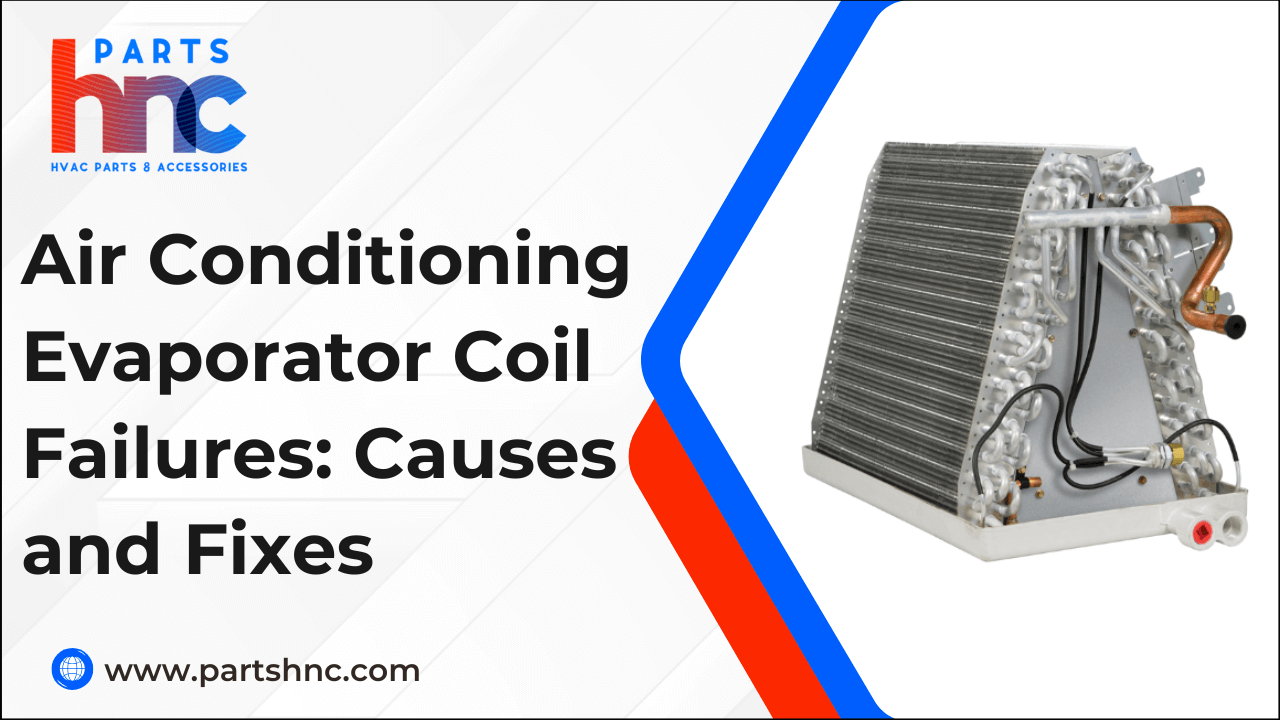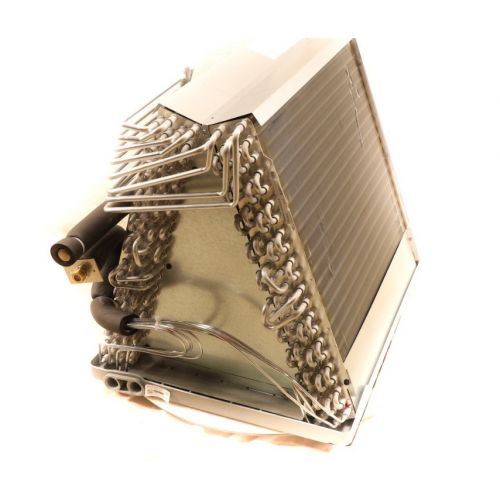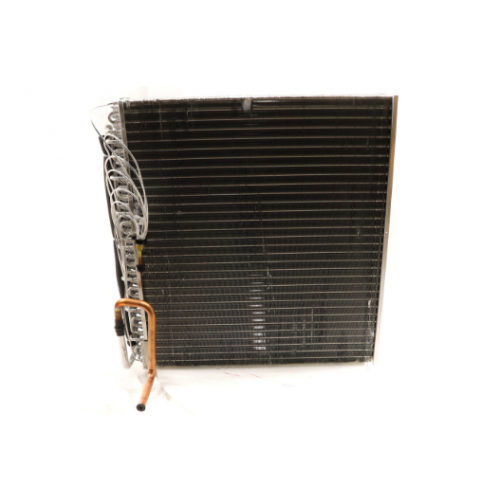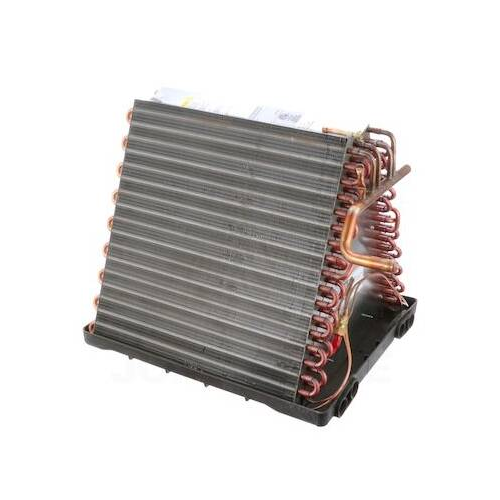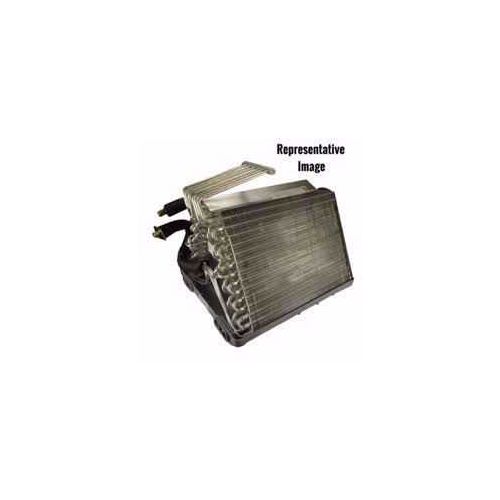Air Conditioning Evaporator Coil Failures: Causes and Fixes
The evaporator coil is an essential component of your air conditioner, responsible for absorbing heat and cooling the air inside your home. When it malfunctions, you may experience reduced cooling, strange odors, or even system shutdowns. Common causes of evaporator coil failure include dirt buildup, refrigerant leaks, poor airflow, and corrosion. These issues can compromise your AC’s performance and lead to higher energy costs. Understanding the causes and knowing how to fix evaporator coil problems can save you time and money. This guide will walk you through the typical reasons for AC conditioner coil failures and offer practical solutions to keep your air conditioning system running smoothly.
What is an Evaporator Coil and Why it’s Crucial for Your AC System
The evaporator coil is a key part of your air conditioning system that is crucial to cooling your house. Usually, it is connected to the furnace or housed inside the indoor air handler. The evaporator coil's main purpose is to:
Key Functions:
-
Initiates the Cooling Cycle: The cooling process starts when heat from the warm indoor air is absorbed by the evaporator coil.
-
Absorbs Heat via Refrigerant: The refrigerant passing through the coil receives the heat that has been absorbed.
-
Facilitates Heat Exchange: Heat is drawn from the air by the refrigerant as it evaporates inside the coil.
-
Delivers Cooled Air to Living Spaces: Before the air is recirculated into your living areas for comfort, the coil cools it.
-
Removes Excess Humidity: It helps remove humidity from the air, improving indoor air quality.
-
Works With Compressor and Condenser: The coil completes the refrigeration cycle in conjunction with the compressor and condenser.
-
Improves Energy Efficiency: A properly functioning coil ensures efficient energy use and lower utility bills.
-
Supports System Longevity and Performance: The longevity and overall effectiveness of your air conditioning system are directly impacted by the state of the evaporator coil.
Frequent evaporator coil maintenance prolongs the life of your air conditioner and keeps it operating efficiently. A healthy coil ensures cool, comfortable air all year long.
Experiencing issues with your air conditioner's evaporator coil? At PartsHnC, you can find top-quality HVAC parts like evaporator coils, expansion valves, and fan blades from top brands like Daikin, Trane, and Lennox to restore your system’s efficiency and keep your cooling system running at its peak.
Signs and Symptoms of a Failing Evaporator Coil in Air Conditioner
A failing evaporator coil can significantly impact your air conditioning system’s performance and your home’s comfort. Recognizing early signs of coil problems can help you fix issues before they turn costly. Common symptoms include:
-
Decreased Cooling Efficiency: Usually the result of a dirty or damaged coil, your air conditioner has trouble reaching the desired temperature or takes longer to chill a room.
-
Ice Buildup: AC coil ice buildup is a common issue where frost or ice forms on or around the coil, usually caused by restricted airflow or low refrigerant levels.
-
Strange Sounds: The air handler's hissing or bubbling sounds could be a sign of coil damage or refrigerant leaks.
-
Increased Energy Bills: A failing coil forces the system to work harder, raising your electricity costs.
-
Frequent Cycling: The compressor is strained as a result of the AC turning ON and OFF more frequently.
-
Musty or Moldy Smell: When your AC coil smells musty, it’s often due to moisture buildup on the coil, which can promote mold growth and affect indoor air quality.
-
Water Leaks: Blocked condensate drains due to coil issues can cause water to leak near the indoor unit.
To maintain effective cooling and stop additional damage, it's critical to get your evaporator coil inspected by a professional if you see any of these symptoms.
What Are the Common Causes of AC Evaporator Coil Failures
Evaporator coil failures often result from a variety of factors that reduce cooling efficiency and damage the system. By being aware of these typical reasons, you can keep your air conditioner operating efficiently and avoid expensive repairs.
-
Dirt and Debris Buildup: Dust, pollen, and other particles accumulate on the coil’s surface, reducing heat absorption and causing the system to overwork.
-
Refrigerant Leaks: Insufficient cooling caused by low refrigerant levels might cause the coil to freeze and possibly shatter.
-
Corrosion: Moisture in humid environments causes the metal components of the coil to deteriorate over time.
-
Poor Maintenance: Infrequent cleaning and neglected inspections accelerate damage and increase failure risk.
-
Airflow Restrictions: The coil freezes when airflow is reduced by dirty air filters or obstructed vents.
-
Electrical Issues: Faulty wiring or thermostat problems can disrupt system operation and indirectly contribute to coil failure.
Identifying and addressing these causes early through regular maintenance helps prevent evaporator coil failures and ensures your AC runs efficiently and reliably.
How to Diagnose and Fix AC Evaporator Coil Issues
Air conditioner evaporator coil problems can lead to poor cooling, higher energy bills, and system breakdowns. Early diagnosis is essential to preventing expensive repairs. With the right steps, many problems can be fixed quickly and efficiently.
Reduced Cooling Efficiency
Issue: Your AC isn’t cooling your home effectively.
Signs:
-
The room consistently stays warmer than the thermostat setting.
-
The AC runs for longer cycles without reaching the desired temperature.
-
Airflow from vents feels weaker or less cool than normal.
-
Higher indoor humidity levels are noticeable.
-
Unusual increase in energy bills.
How to Fix:
-
Replace or Clean Air Filters: To guarantee adequate airflow, clean or replace any filthy air filters.
-
Clean the Evaporator Coil: To improve heat transfer, clear the evaporator coil of dust and debris.
-
Open and Unblock Vents: For improved ventilation, make sure all registers and vents are open and unimpeded.
-
Check Thermostat Settings and Functionality: Ensure the thermostat is set correctly (e.g., "Cool" mode, correct temperature), and replace batteries or recalibrate if it’s not responding properly.
-
Schedule HVAC Maintenance: To keep the HVAC system operating effectively, schedule routine maintenance.
Pro Tip: To keep your system operating at peak efficiency, plan routine HVAC tune-ups before summer arrives.
Ice Buildup on the Coil
Issue: Frost or ice is forming on or around the evaporator coil.
Signs:
-
Visible frost or ice on the evaporator coil or nearby components.
-
Air from vents feels colder but weaker than usual.
-
The system has short cycles (turns on and off quickly).
-
Dirty or clogged air filters.
-
Excess moisture or water around the indoor unit after thawing.
How to Fix:
-
Turn Off and Thaw the System: Before restarting, turn off the AC and let the ice completely melt.
-
Replace Dirty Filters: Remove and replace any clogged or dirty air filters to restore airflow.
-
Check and Clear Air Vents: Ensure all vents and ducts are free from obstructions for proper airflow.
-
Check Refrigerant Levels: Contact a technician to check refrigerant and repair leaks if necessary.
Pro Tip: Avoid running your AC when ice buildup is present to prevent compressor damage.
Refrigerant Leaks
Issue: Your AC is low on refrigerant, causing poor cooling and possible coil freezing.
Signs:
-
Ice buildup on the coil despite normal airflow.
-
Decline in cooling performance and longer run times.
-
Hissing sounds indicate possible refrigerant leaks.
-
Warm air coming from vents when cooling is expected.
How to Fix:
-
Locate and Seal Leaks: Have a certified HVAC technician find and repair any refrigerant leaks.
-
Recharge Refrigerant: Recharge the system with the correct amount recommended by the manufacturer.
-
Replace Damaged Components: Replace coils or lines if leaks are severe or parts are damaged.
-
Schedule Regular Refrigerant Checks: Maintain regular inspections to avoid future leaks.
-
Avoid DIY Refrigerant Handling: Adding refrigerant yourself is illegal and can harm your system.
Pro Tip: Avoid trying to add refrigerant on your own as it is against the law and can harm your system.
Dirty or Clogged Coil
Issue: There is dust, grime, or debris all over the evaporator coil.
Signs:
-
Shine a flashlight on the coil to identify accumulated dirt and debris.
-
Notice if cooling efficiency has dropped recently.
-
Check for uneven cooling or warm spots in your home.
-
Observe if the system is running longer than usual.
-
Increased dust or allergy symptoms indoors.
How to Fix:
-
Clean the Coil Gently: Use a no-rinse coil cleaner spray or a soft brush to remove dirt.
-
Remove Nearby Dust Sources: Keep the area around your indoor unit clean to avoid recontamination.
-
Replace Air Filters Frequently: Regularly change filters to reduce dust buildup.
-
Schedule Professional Cleaning: Call for professional coil cleaning if heavily soiled.
-
Inspect Insulation: Check and repair insulation around ducts and coils to reduce dust accumulation.
Pro Tip: Keep the area around your indoor unit clean to minimize dirt buildup on coils.
Poor Airflow
Issue: Blocked filters or vents are restricting air from passing over the coil.
Signs:
-
Dust or particle buildup on air filters.
-
Supply and return vents are closed or blocked.
-
Weak or sluggish airflow from vents.
-
Unusual noises indicate blower motor strain.
-
Uneven temperatures in different rooms.
How to Fix:
-
Clean or Replace Air Filters: Change filters monthly during high-use seasons to maintain airflow.
-
Remove Obstructions: Clear furniture, rugs, or curtains blocking vents and registers.
-
Inspect and Clean Ductwork: Remove buildup or blockages inside ductwork.
-
Repair or Replace Blower Motor: If airflow remains weak, have the blower motor checked and repaired.
-
Seal Duct Leaks: Seal any leaks in ductwork to improve airflow efficiency.
Pro Tip: Use high-quality air filters that balance filtration and airflow to keep your system healthy.
Mold or Musty Odor
Issue: A musty smell near the AC suggests mold growth on the coil.
Signs:
-
Persistent musty or mildew-like odors when the AC runs.
-
Visible mold or moisture buildup on the coil or drain pan.
-
Slow or clogged condensate drain line.
-
Increased allergy symptoms or respiratory irritation indoors.
-
High indoor humidity levels.
How to Fix:
-
Clean Coil and Surroundings: Use mold-killing solutions to clean the evaporator coil and drain pan.
-
Clear and Disinfect Drain Line: Prevent water backup by cleaning the condensate drain line.
-
Improve Ventilation and Humidity Control: Use fans, dehumidifiers, or ventilation improvements.
-
Install UV Light System: UV lights in the air handler can help prevent mold growth.
-
Call Professionals for Mold Removal: If mold persists, seek expert mold remediation services.
Pro Tip: Use a UV light inside the air handler to help prevent mold growth on coils and drain pans.
Check out our guide on AC evaporator coil replacement cost to understand pricing, key factors, and what to expect during the replacement process.
How to Prevent Future AC Evaporator Coil Failures
Preventing evaporator coil failures is far more affordable and convenient than repairing or replacing them. With simple, regular maintenance steps, you can avoid most issues, improve your AC's efficiency, and extend its lifespan.
-
Change Air Filters Frequently: To ensure enough airflow and avoid dust accumulation on the evaporator coil, change your air filters every one to three months.
-
Schedule Annual HVAC Inspections: Have a professional technician inspect your system once a year to catch early signs of corrosion, leaks, or damage before they worsen.
-
Keep the Outdoor Unit Clear of Debris: To guarantee the best possible airflow and cooling effectiveness, clear the area surrounding the outdoor unit of leaves, dirt, grass clippings, and other debris.
-
Ensure Vents and Registers Are Unblocked: Keep furniture, rugs, and curtains away from air vents and registers to allow proper airflow throughout your home.
-
Avoid Harsh Chemicals or DIY Coil Cleaners: Using incorrect cleaning products can damage the coil’s protective coating—stick to approved coil cleaners or hire a professional.
-
Monitor for Moisture and Mold: Check for signs of moisture accumulation or mold around the coil, and clear clogged drain lines to avoid long-term water damage.
-
Maintain Balanced Indoor Humidity Levels: Use a dehumidifier if necessary to reduce indoor humidity, which can help prevent coil corrosion and improve system performance.
Check out this guide on how to clean an air conditioner yourself for easy DIY steps to keep your system clean and efficient.
Proper care and timely diagnosis of AC evaporator coil issues are essential for maintaining an efficient and reliable air conditioning system. By understanding common causes, recognizing warning signs, and taking preventive measures, you can extend the life of your air conditioner and avoid costly repairs. When issues go beyond basic maintenance, contacting a professional technician ensures safe and effective solutions, keeping your home cool and comfortable year-round. Regular inspections can help catch minor problems before they escalate, and ensuring proper airflow around the unit also enhances overall performance. Consistent upkeep not only improves efficiency but also contributes to healthier indoor air quality.
FAQs
Where is the evaporator coil in air conditioning?
The evaporator coil in an air conditioning system is typically located inside the indoor air handler or attached to the furnace. It sits near the blower fan, where it absorbs heat from the indoor air as it passes over the coil.
How does an evaporator coil break?
Coils break when they develop leaks, get clogged with debris, or corrode from moisture exposure. Physical damage or freezing caused by airflow problems can also cause cracks or ruptures.
How to clean air conditioning evaporator coils?
To clean air conditioning evaporator coils, turn off the power and gently remove dust and debris using a soft brush or a no-rinse coil cleaner. For deeper cleaning, use a commercial foaming cleaner and rinse with water if accessible, or contact a professional for safe handling.
How can I prevent AC coil sensor failure?
Routine maintenance, keeping the coil clean, ensuring good airflow, and inspecting electrical components during service visits can help prevent sensor issues.


